Business Environment, Marketing, Ethics, and Culture Analysis Report
VerifiedAdded on 2022/07/14
|18
|2924
|21
Report
AI Summary
This report provides a comprehensive analysis of the business environment, encompassing external factors, environmental impacts, and crisis management. It delves into PESTLE analysis, exploring the political, economic, social, technological, environmental, and legal factors influencing businesses. The report also examines marketing functions, including selling, product management, pricing, and distribution, and outlines the components of a marketing plan. Furthermore, it addresses ethical considerations, the benefits of ethical behavior in organizations, and the impact of organizational culture on business outcomes. The report emphasizes the importance of understanding these elements for effective business management and sustainable growth. It also explores how a lack of care for the environment can impact business profitability and reputation.
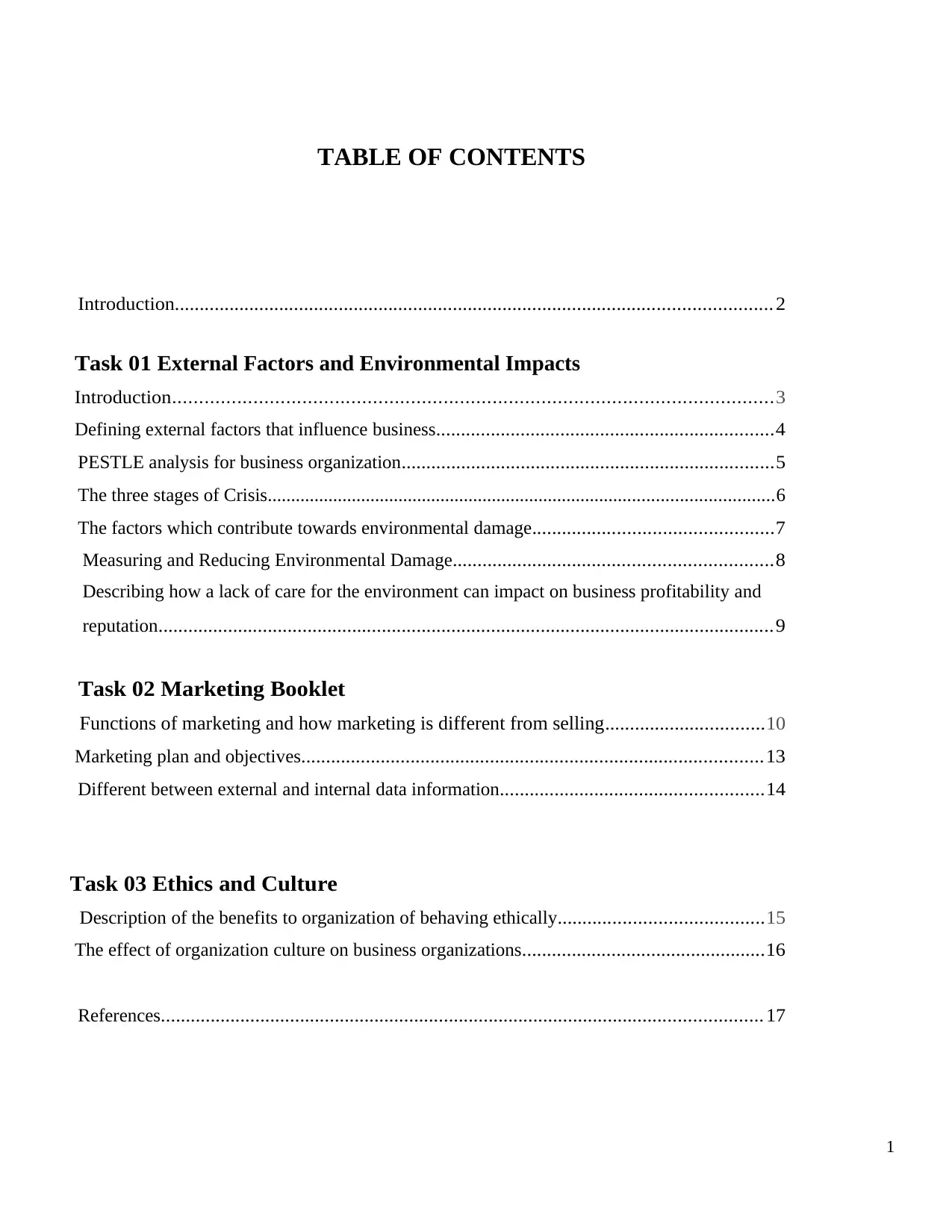
TABLE OF CONTENTS
Introduction........................................................................................................................ 2
Task 01 External Factors and Environmental Impacts
Introduction...............................................................................................................3
Defining external factors that influence business ....................................................................4
PESTLE analysis for business organization ...........................................................................5
The three stages of Crisis............................................................................................................6
The factors which contribute towards environmental damage ................................................7
Measuring and Reducing Environmental Damage ................................................................8
Describing how a lack of care for the environment can impact on business profitability and
reputation ............................................................................................................................9
Task 02 Marketing Booklet
Functions of marketing and how marketing is different from selling ................................10
Marketing plan and objectives .............................................................................................13
Different between external and internal data information .....................................................14
Task 03 Ethics and Culture
Description of the benefits to organization of behaving ethically .........................................15
The effect of organization culture on business organizations .................................................16
References ......................................................................................................................... 17
1
Introduction........................................................................................................................ 2
Task 01 External Factors and Environmental Impacts
Introduction...............................................................................................................3
Defining external factors that influence business ....................................................................4
PESTLE analysis for business organization ...........................................................................5
The three stages of Crisis............................................................................................................6
The factors which contribute towards environmental damage ................................................7
Measuring and Reducing Environmental Damage ................................................................8
Describing how a lack of care for the environment can impact on business profitability and
reputation ............................................................................................................................9
Task 02 Marketing Booklet
Functions of marketing and how marketing is different from selling ................................10
Marketing plan and objectives .............................................................................................13
Different between external and internal data information .....................................................14
Task 03 Ethics and Culture
Description of the benefits to organization of behaving ethically .........................................15
The effect of organization culture on business organizations .................................................16
References ......................................................................................................................... 17
1
Paraphrase This Document
Need a fresh take? Get an instant paraphrase of this document with our AI Paraphraser
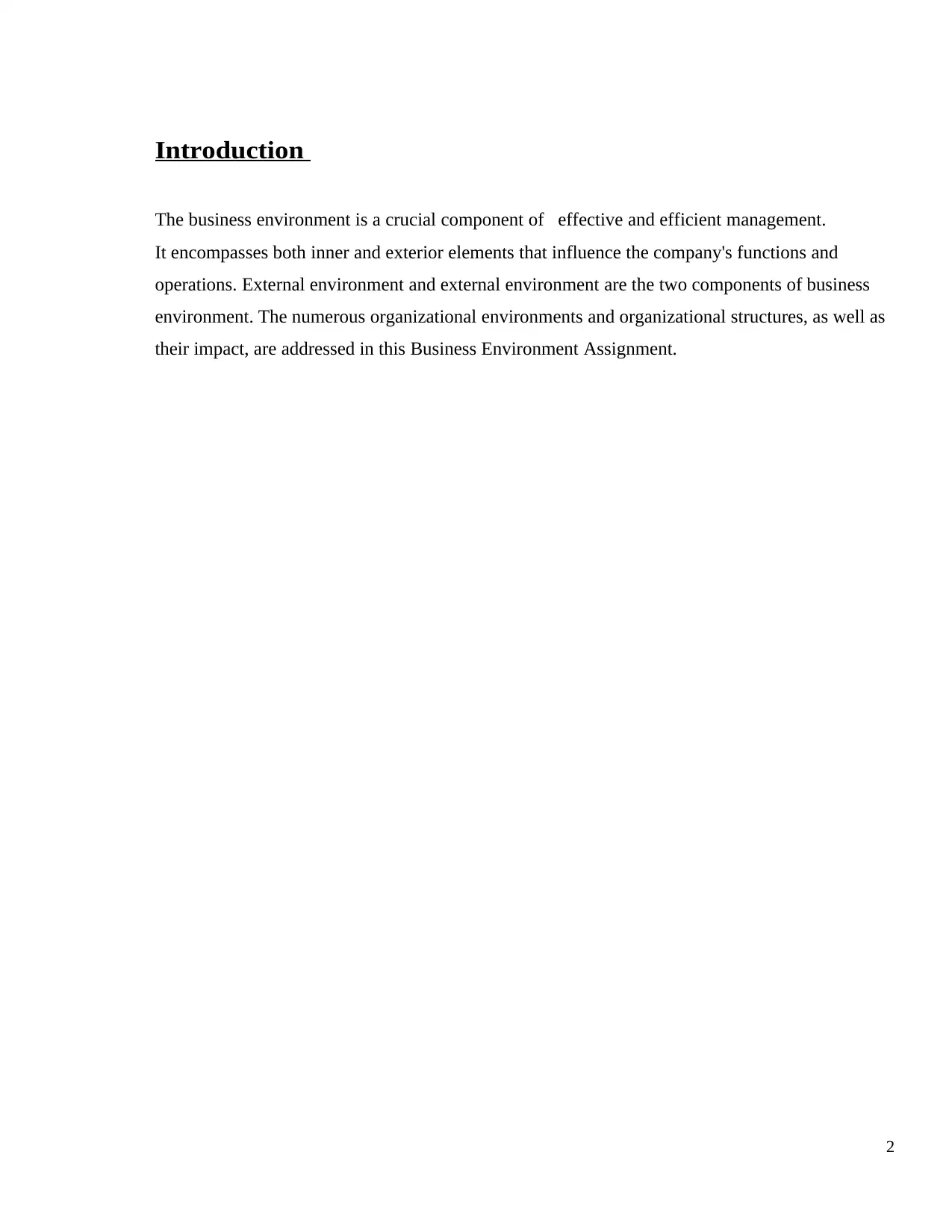
Introduction
The business environment is a crucial component of effective and efficient management.
It encompasses both inner and exterior elements that influence the company's functions and
operations. External environment and external environment are the two components of business
environment. The numerous organizational environments and organizational structures, as well as
their impact, are addressed in this Business Environment Assignment.
2
The business environment is a crucial component of effective and efficient management.
It encompasses both inner and exterior elements that influence the company's functions and
operations. External environment and external environment are the two components of business
environment. The numerous organizational environments and organizational structures, as well as
their impact, are addressed in this Business Environment Assignment.
2
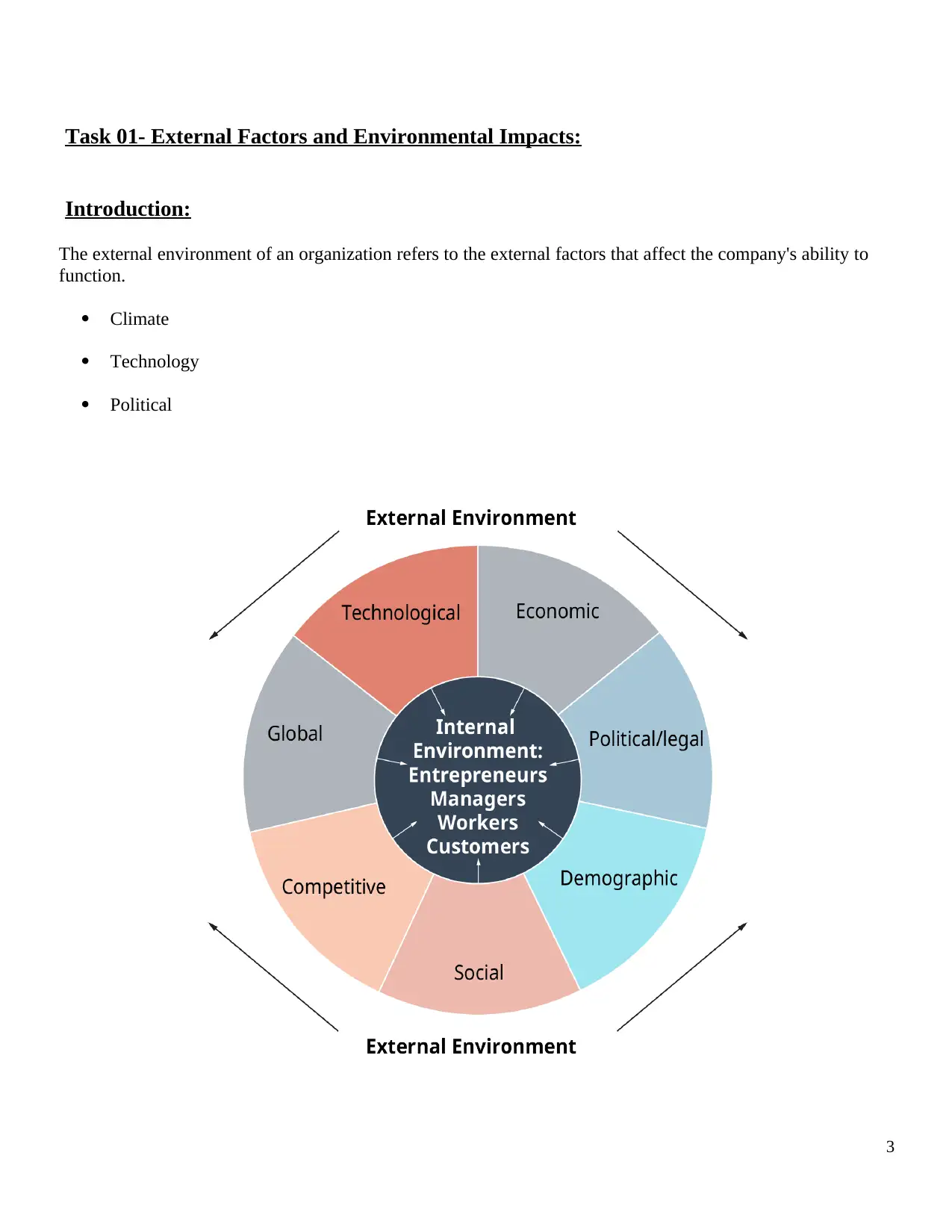
Task 01- External Factors and Environmental Impacts:
Introduction:
The external environment of an organization refers to the external factors that affect the company's ability to
function.
Climate
Technology
Political
3
Introduction:
The external environment of an organization refers to the external factors that affect the company's ability to
function.
Climate
Technology
Political
3
⊘ This is a preview!⊘
Do you want full access?
Subscribe today to unlock all pages.

Trusted by 1+ million students worldwide
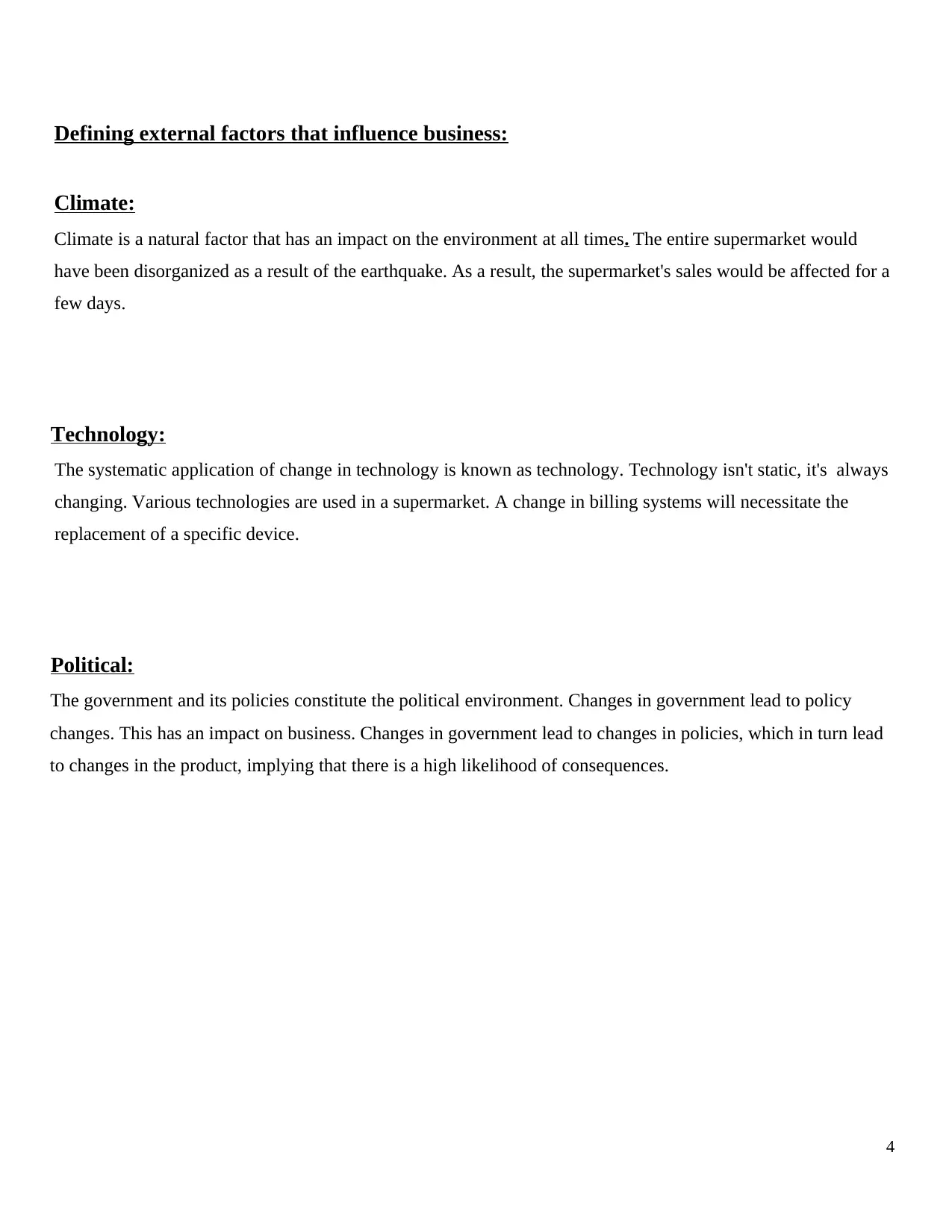
Defining external factors that influence business:
Climate:
Climate is a natural factor that has an impact on the environment at all times. The entire supermarket would
have been disorganized as a result of the earthquake. As a result, the supermarket's sales would be affected for a
few days.
Technology:
The systematic application of change in technology is known as technology. Technology isn't static, it's always
changing. Various technologies are used in a supermarket. A change in billing systems will necessitate the
replacement of a specific device.
Political:
The government and its policies constitute the political environment. Changes in government lead to policy
changes. This has an impact on business. Changes in government lead to changes in policies, which in turn lead
to changes in the product, implying that there is a high likelihood of consequences.
4
Climate:
Climate is a natural factor that has an impact on the environment at all times. The entire supermarket would
have been disorganized as a result of the earthquake. As a result, the supermarket's sales would be affected for a
few days.
Technology:
The systematic application of change in technology is known as technology. Technology isn't static, it's always
changing. Various technologies are used in a supermarket. A change in billing systems will necessitate the
replacement of a specific device.
Political:
The government and its policies constitute the political environment. Changes in government lead to policy
changes. This has an impact on business. Changes in government lead to changes in policies, which in turn lead
to changes in the product, implying that there is a high likelihood of consequences.
4
Paraphrase This Document
Need a fresh take? Get an instant paraphrase of this document with our AI Paraphraser
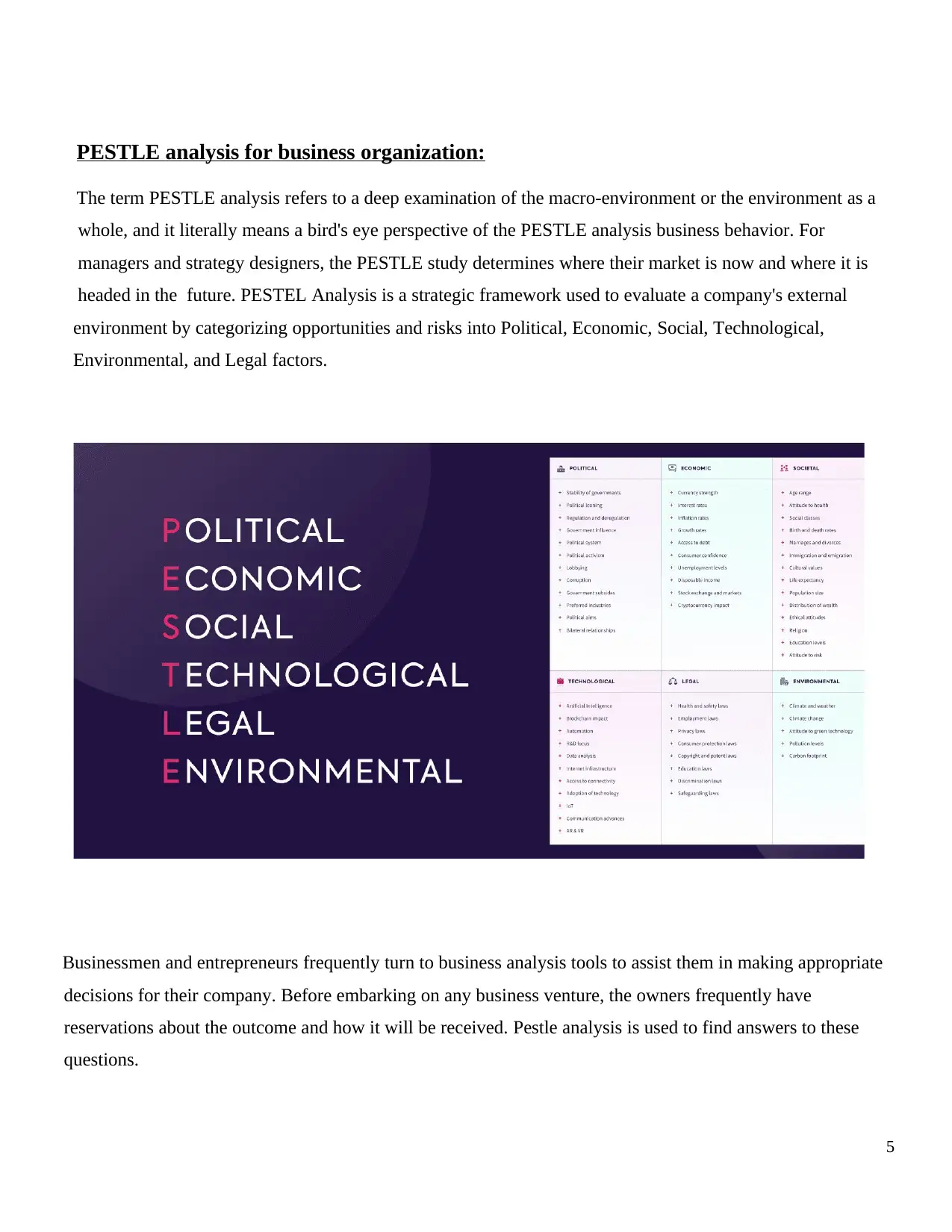
PESTLE analysis for business organization:
The term PESTLE analysis refers to a deep examination of the macro-environment or the environment as a
whole, and it literally means a bird's eye perspective of the PESTLE analysis business behavior. For
managers and strategy designers, the PESTLE study determines where their market is now and where it is
headed in the future. PESTEL Analysis is a strategic framework used to evaluate a company's external
environment by categorizing opportunities and risks into Political, Economic, Social, Technological,
Environmental, and Legal factors.
Businessmen and entrepreneurs frequently turn to business analysis tools to assist them in making appropriate
decisions for their company. Before embarking on any business venture, the owners frequently have
reservations about the outcome and how it will be received. Pestle analysis is used to find answers to these
questions.
5
The term PESTLE analysis refers to a deep examination of the macro-environment or the environment as a
whole, and it literally means a bird's eye perspective of the PESTLE analysis business behavior. For
managers and strategy designers, the PESTLE study determines where their market is now and where it is
headed in the future. PESTEL Analysis is a strategic framework used to evaluate a company's external
environment by categorizing opportunities and risks into Political, Economic, Social, Technological,
Environmental, and Legal factors.
Businessmen and entrepreneurs frequently turn to business analysis tools to assist them in making appropriate
decisions for their company. Before embarking on any business venture, the owners frequently have
reservations about the outcome and how it will be received. Pestle analysis is used to find answers to these
questions.
5
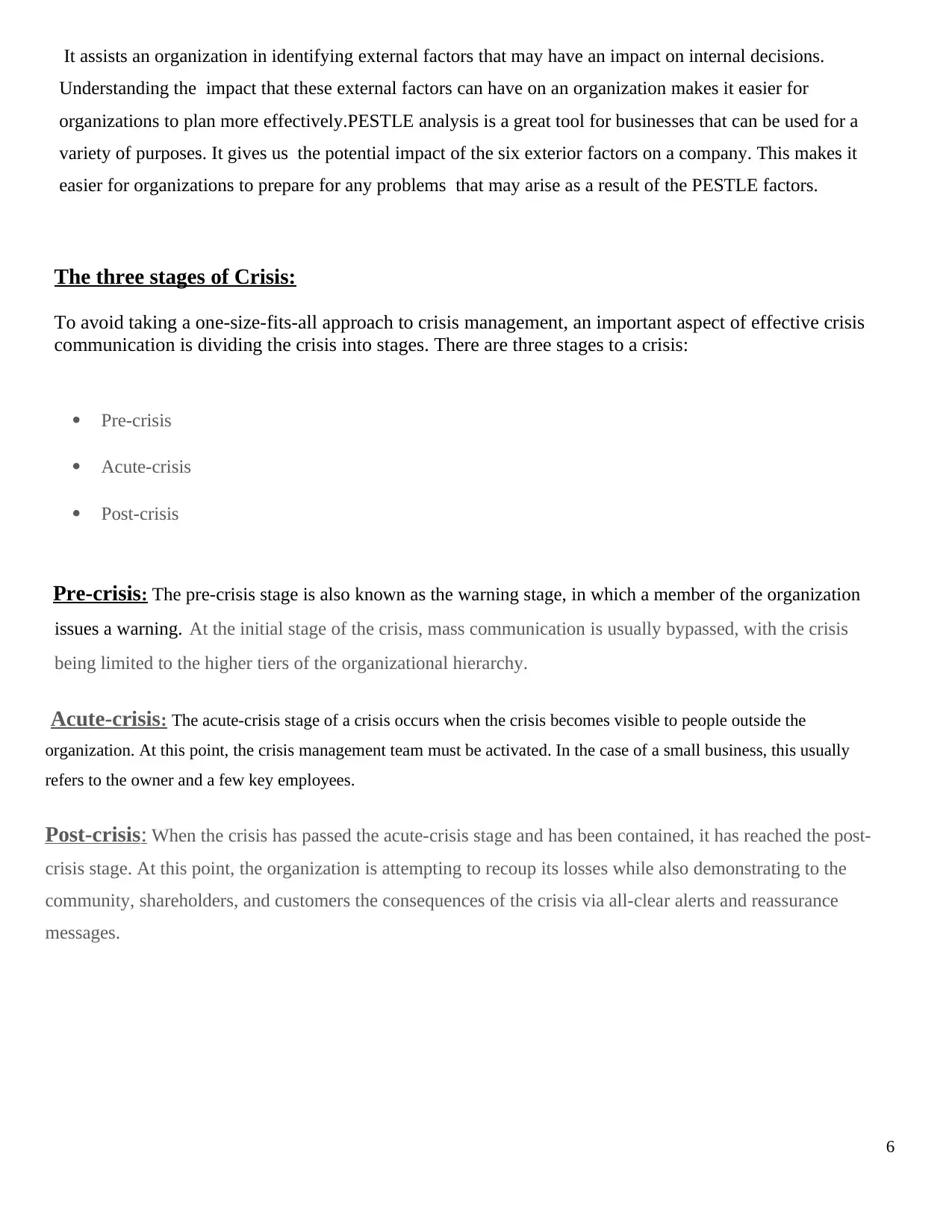
It assists an organization in identifying external factors that may have an impact on internal decisions.
Understanding the impact that these external factors can have on an organization makes it easier for
organizations to plan more effectively.PESTLE analysis is a great tool for businesses that can be used for a
variety of purposes. It gives us the potential impact of the six exterior factors on a company. This makes it
easier for organizations to prepare for any problems that may arise as a result of the PESTLE factors.
The three stages of Crisis:
To avoid taking a one-size-fits-all approach to crisis management, an important aspect of effective crisis
communication is dividing the crisis into stages. There are three stages to a crisis:
Pre-crisis
Acute-crisis
Post-crisis
Pre-crisis: The pre-crisis stage is also known as the warning stage, in which a member of the organization
issues a warning. At the initial stage of the crisis, mass communication is usually bypassed, with the crisis
being limited to the higher tiers of the organizational hierarchy.
Acute-crisis: The acute-crisis stage of a crisis occurs when the crisis becomes visible to people outside the
organization. At this point, the crisis management team must be activated. In the case of a small business, this usually
refers to the owner and a few key employees.
Post-crisis: When the crisis has passed the acute-crisis stage and has been contained, it has reached the post-
crisis stage. At this point, the organization is attempting to recoup its losses while also demonstrating to the
community, shareholders, and customers the consequences of the crisis via all-clear alerts and reassurance
messages.
6
Understanding the impact that these external factors can have on an organization makes it easier for
organizations to plan more effectively.PESTLE analysis is a great tool for businesses that can be used for a
variety of purposes. It gives us the potential impact of the six exterior factors on a company. This makes it
easier for organizations to prepare for any problems that may arise as a result of the PESTLE factors.
The three stages of Crisis:
To avoid taking a one-size-fits-all approach to crisis management, an important aspect of effective crisis
communication is dividing the crisis into stages. There are three stages to a crisis:
Pre-crisis
Acute-crisis
Post-crisis
Pre-crisis: The pre-crisis stage is also known as the warning stage, in which a member of the organization
issues a warning. At the initial stage of the crisis, mass communication is usually bypassed, with the crisis
being limited to the higher tiers of the organizational hierarchy.
Acute-crisis: The acute-crisis stage of a crisis occurs when the crisis becomes visible to people outside the
organization. At this point, the crisis management team must be activated. In the case of a small business, this usually
refers to the owner and a few key employees.
Post-crisis: When the crisis has passed the acute-crisis stage and has been contained, it has reached the post-
crisis stage. At this point, the organization is attempting to recoup its losses while also demonstrating to the
community, shareholders, and customers the consequences of the crisis via all-clear alerts and reassurance
messages.
6
⊘ This is a preview!⊘
Do you want full access?
Subscribe today to unlock all pages.

Trusted by 1+ million students worldwide
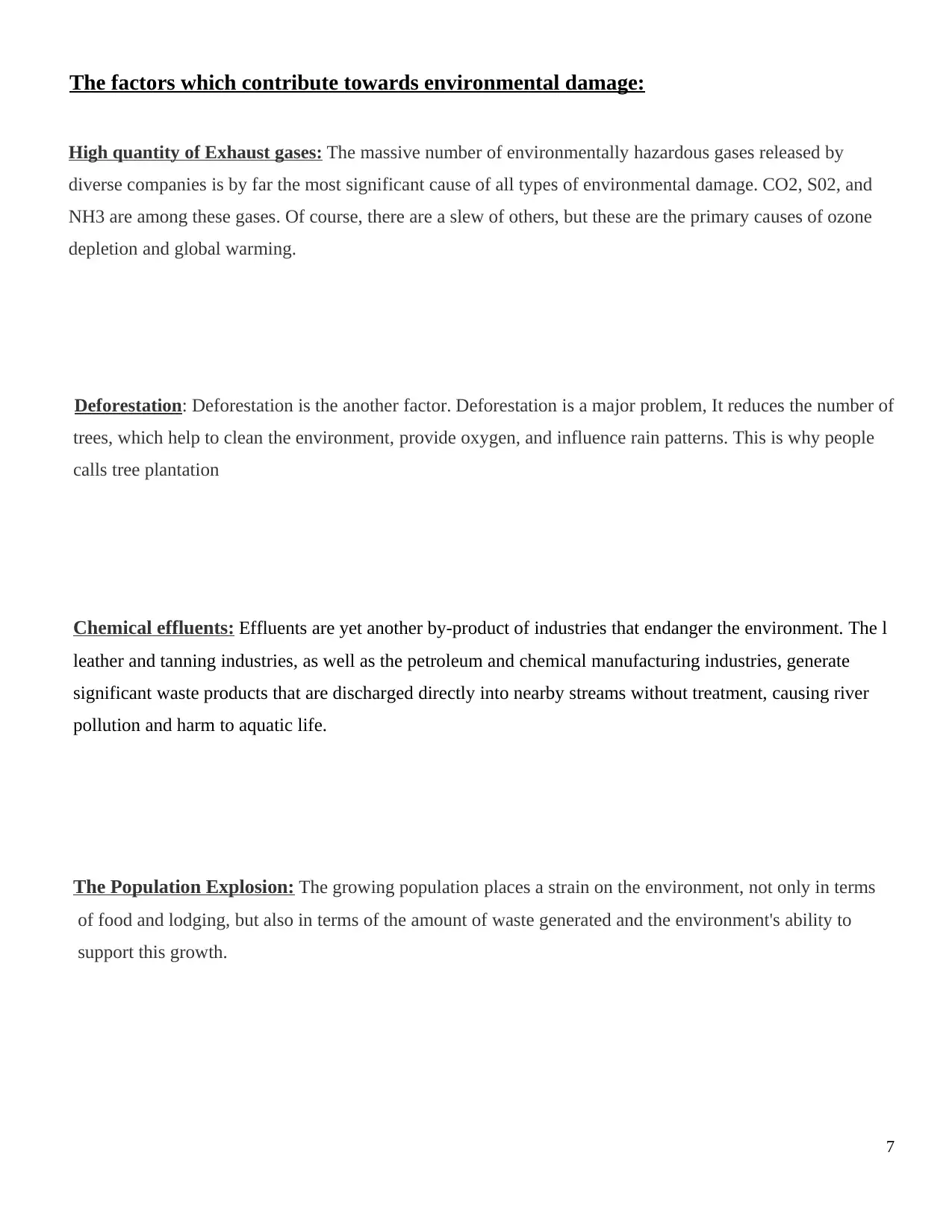
The factors which contribute towards environmental damage:
High quantity of Exhaust gases: The massive number of environmentally hazardous gases released by
diverse companies is by far the most significant cause of all types of environmental damage. CO2, S02, and
NH3 are among these gases. Of course, there are a slew of others, but these are the primary causes of ozone
depletion and global warming.
Deforestation: Deforestation is the another factor. Deforestation is a major problem, It reduces the number of
trees, which help to clean the environment, provide oxygen, and influence rain patterns. This is why people
calls tree plantation
Chemical effluents: Effluents are yet another by-product of industries that endanger the environment. The l
leather and tanning industries, as well as the petroleum and chemical manufacturing industries, generate
significant waste products that are discharged directly into nearby streams without treatment, causing river
pollution and harm to aquatic life.
The Population Explosion: The growing population places a strain on the environment, not only in terms
of food and lodging, but also in terms of the amount of waste generated and the environment's ability to
support this growth.
7
High quantity of Exhaust gases: The massive number of environmentally hazardous gases released by
diverse companies is by far the most significant cause of all types of environmental damage. CO2, S02, and
NH3 are among these gases. Of course, there are a slew of others, but these are the primary causes of ozone
depletion and global warming.
Deforestation: Deforestation is the another factor. Deforestation is a major problem, It reduces the number of
trees, which help to clean the environment, provide oxygen, and influence rain patterns. This is why people
calls tree plantation
Chemical effluents: Effluents are yet another by-product of industries that endanger the environment. The l
leather and tanning industries, as well as the petroleum and chemical manufacturing industries, generate
significant waste products that are discharged directly into nearby streams without treatment, causing river
pollution and harm to aquatic life.
The Population Explosion: The growing population places a strain on the environment, not only in terms
of food and lodging, but also in terms of the amount of waste generated and the environment's ability to
support this growth.
7
Paraphrase This Document
Need a fresh take? Get an instant paraphrase of this document with our AI Paraphraser
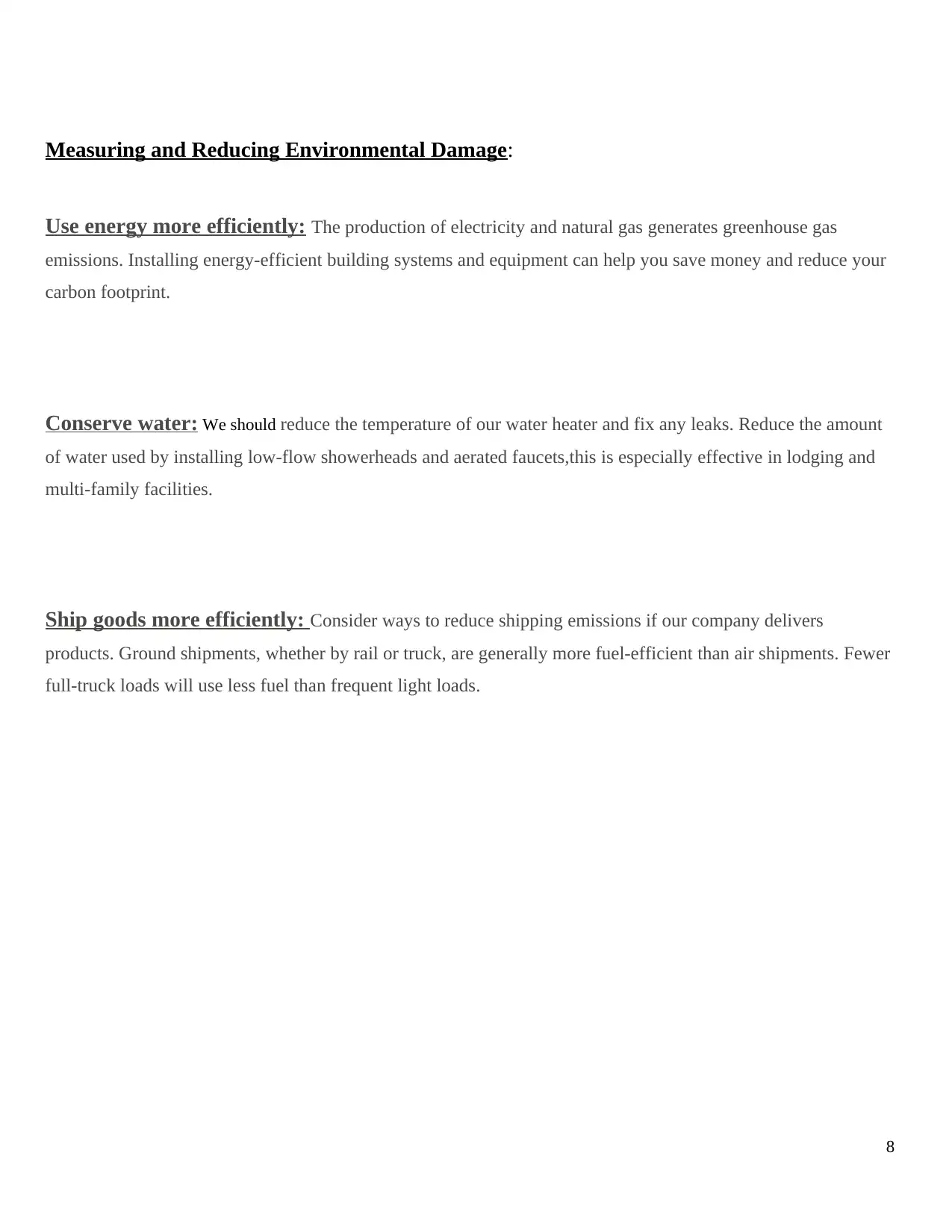
Measuring and Reducing Environmental Damage:
Use energy more efficiently: The production of electricity and natural gas generates greenhouse gas
emissions. Installing energy-efficient building systems and equipment can help you save money and reduce your
carbon footprint.
Conserve water: We should reduce the temperature of our water heater and fix any leaks. Reduce the amount
of water used by installing low-flow showerheads and aerated faucets,this is especially effective in lodging and
multi-family facilities.
Ship goods more efficiently: Consider ways to reduce shipping emissions if our company delivers
products. Ground shipments, whether by rail or truck, are generally more fuel-efficient than air shipments. Fewer
full-truck loads will use less fuel than frequent light loads.
8
Use energy more efficiently: The production of electricity and natural gas generates greenhouse gas
emissions. Installing energy-efficient building systems and equipment can help you save money and reduce your
carbon footprint.
Conserve water: We should reduce the temperature of our water heater and fix any leaks. Reduce the amount
of water used by installing low-flow showerheads and aerated faucets,this is especially effective in lodging and
multi-family facilities.
Ship goods more efficiently: Consider ways to reduce shipping emissions if our company delivers
products. Ground shipments, whether by rail or truck, are generally more fuel-efficient than air shipments. Fewer
full-truck loads will use less fuel than frequent light loads.
8
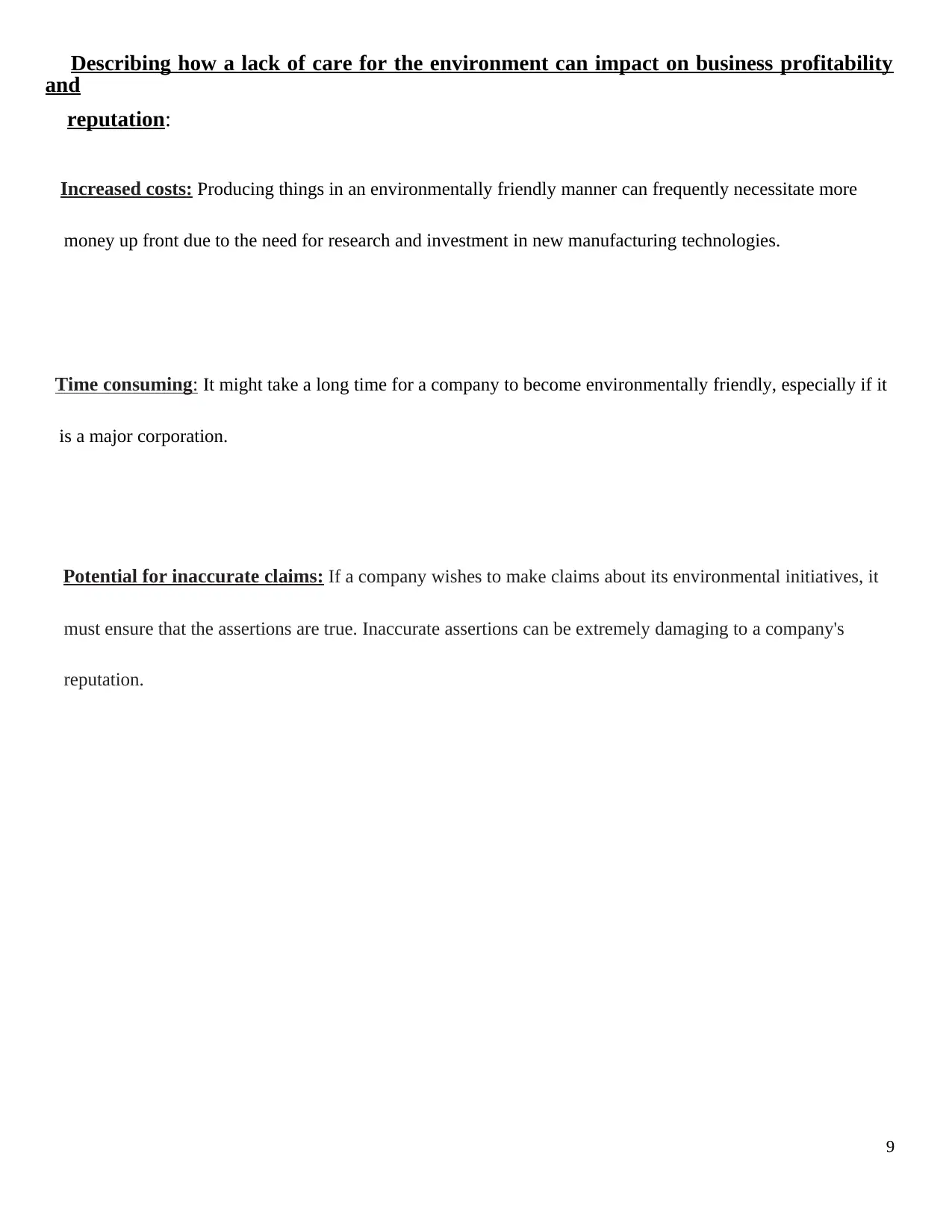
Describing how a lack of care for the environment can impact on business profitability
and
reputation:
Increased costs: Producing things in an environmentally friendly manner can frequently necessitate more
money up front due to the need for research and investment in new manufacturing technologies.
Time consuming: It might take a long time for a company to become environmentally friendly, especially if it
is a major corporation.
Potential for inaccurate claims: If a company wishes to make claims about its environmental initiatives, it
must ensure that the assertions are true. Inaccurate assertions can be extremely damaging to a company's
reputation.
9
and
reputation:
Increased costs: Producing things in an environmentally friendly manner can frequently necessitate more
money up front due to the need for research and investment in new manufacturing technologies.
Time consuming: It might take a long time for a company to become environmentally friendly, especially if it
is a major corporation.
Potential for inaccurate claims: If a company wishes to make claims about its environmental initiatives, it
must ensure that the assertions are true. Inaccurate assertions can be extremely damaging to a company's
reputation.
9
⊘ This is a preview!⊘
Do you want full access?
Subscribe today to unlock all pages.

Trusted by 1+ million students worldwide
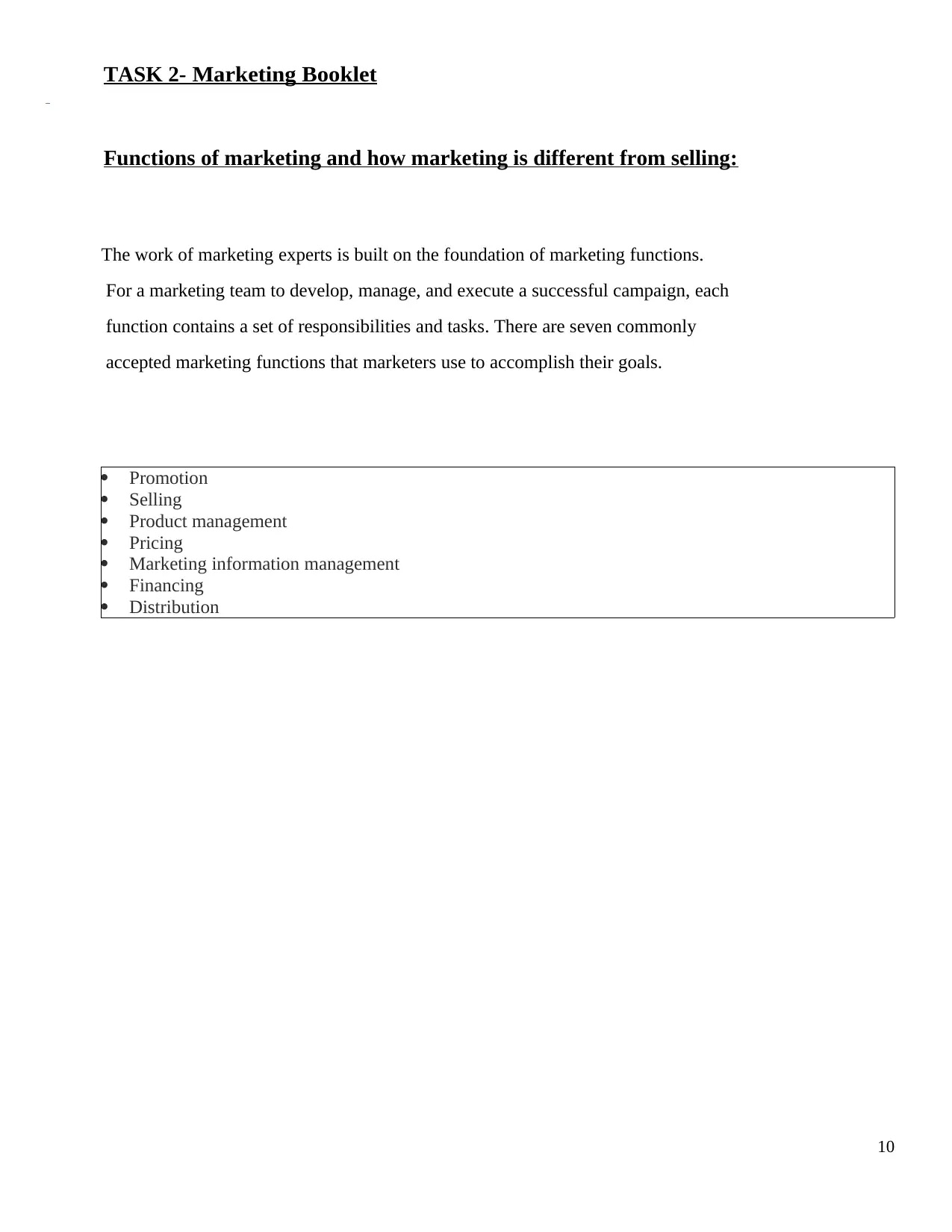
TASK 2- Marketing Booklet
Functions of marketing and how marketing is different from selling:
The work of marketing experts is built on the foundation of marketing functions.
For a marketing team to develop, manage, and execute a successful campaign, each
function contains a set of responsibilities and tasks. There are seven commonly
accepted marketing functions that marketers use to accomplish their goals.
Promotion
Selling
Product management
Pricing
Marketing information management
Financing
Distribution
10
Functions of marketing and how marketing is different from selling:
The work of marketing experts is built on the foundation of marketing functions.
For a marketing team to develop, manage, and execute a successful campaign, each
function contains a set of responsibilities and tasks. There are seven commonly
accepted marketing functions that marketers use to accomplish their goals.
Promotion
Selling
Product management
Pricing
Marketing information management
Financing
Distribution
10
Paraphrase This Document
Need a fresh take? Get an instant paraphrase of this document with our AI Paraphraser
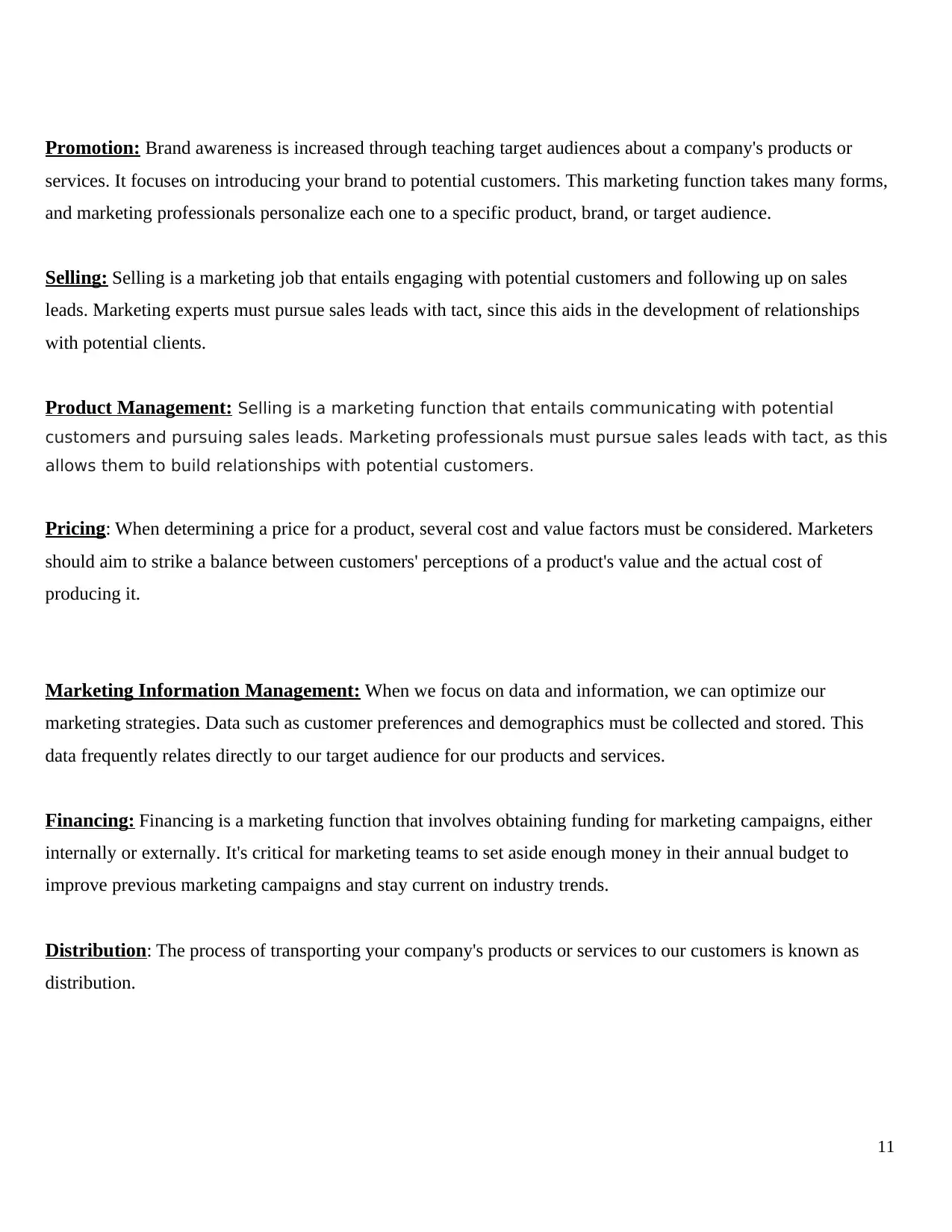
Promotion: Brand awareness is increased through teaching target audiences about a company's products or
services. It focuses on introducing your brand to potential customers. This marketing function takes many forms,
and marketing professionals personalize each one to a specific product, brand, or target audience.
Selling: Selling is a marketing job that entails engaging with potential customers and following up on sales
leads. Marketing experts must pursue sales leads with tact, since this aids in the development of relationships
with potential clients.
Product Management: Selling is a marketing function that entails communicating with potential
customers and pursuing sales leads. Marketing professionals must pursue sales leads with tact, as this
allows them to build relationships with potential customers.
Pricing: When determining a price for a product, several cost and value factors must be considered. Marketers
should aim to strike a balance between customers' perceptions of a product's value and the actual cost of
producing it.
Marketing Information Management: When we focus on data and information, we can optimize our
marketing strategies. Data such as customer preferences and demographics must be collected and stored. This
data frequently relates directly to our target audience for our products and services.
Financing: Financing is a marketing function that involves obtaining funding for marketing campaigns, either
internally or externally. It's critical for marketing teams to set aside enough money in their annual budget to
improve previous marketing campaigns and stay current on industry trends.
Distribution: The process of transporting your company's products or services to our customers is known as
distribution.
11
services. It focuses on introducing your brand to potential customers. This marketing function takes many forms,
and marketing professionals personalize each one to a specific product, brand, or target audience.
Selling: Selling is a marketing job that entails engaging with potential customers and following up on sales
leads. Marketing experts must pursue sales leads with tact, since this aids in the development of relationships
with potential clients.
Product Management: Selling is a marketing function that entails communicating with potential
customers and pursuing sales leads. Marketing professionals must pursue sales leads with tact, as this
allows them to build relationships with potential customers.
Pricing: When determining a price for a product, several cost and value factors must be considered. Marketers
should aim to strike a balance between customers' perceptions of a product's value and the actual cost of
producing it.
Marketing Information Management: When we focus on data and information, we can optimize our
marketing strategies. Data such as customer preferences and demographics must be collected and stored. This
data frequently relates directly to our target audience for our products and services.
Financing: Financing is a marketing function that involves obtaining funding for marketing campaigns, either
internally or externally. It's critical for marketing teams to set aside enough money in their annual budget to
improve previous marketing campaigns and stay current on industry trends.
Distribution: The process of transporting your company's products or services to our customers is known as
distribution.
11
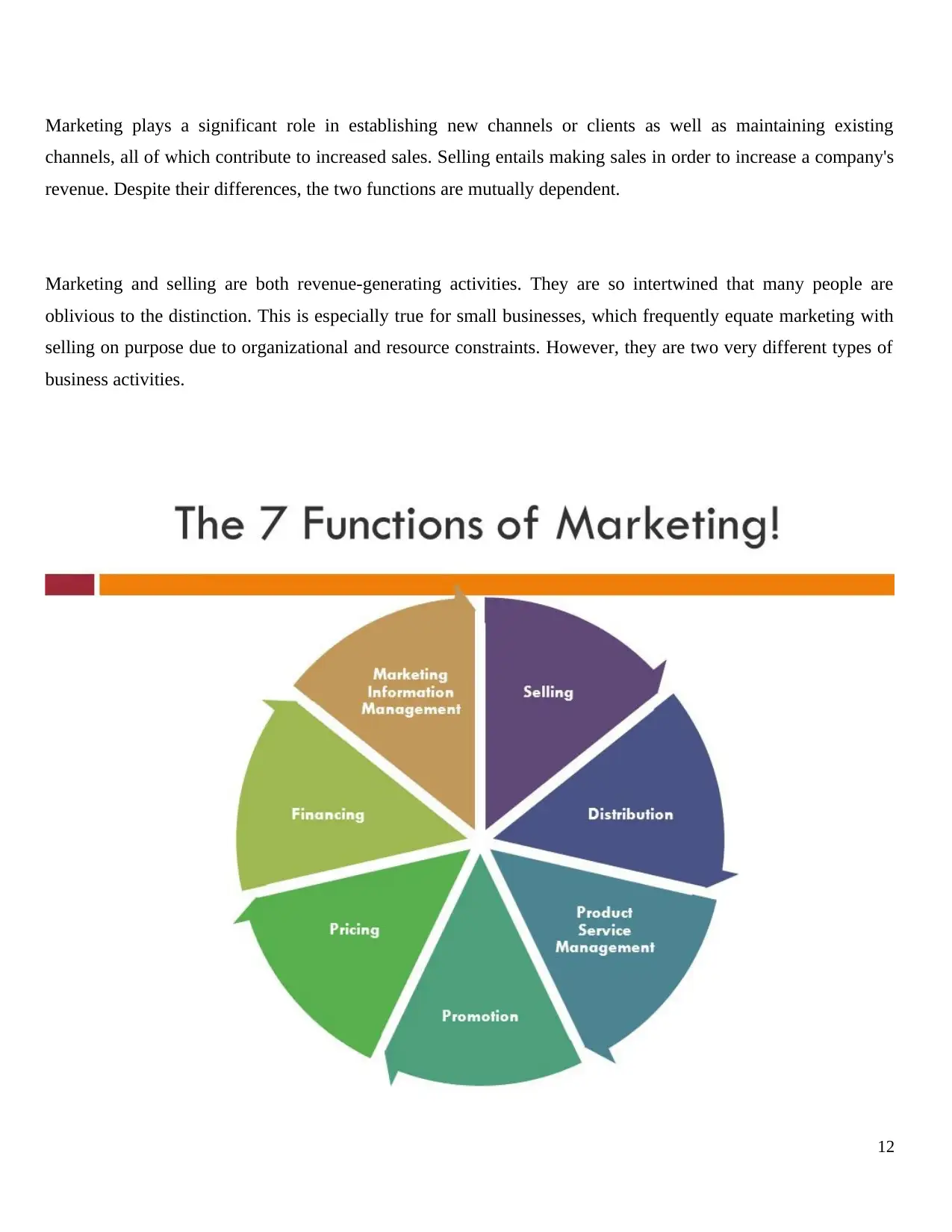
Marketing plays a significant role in establishing new channels or clients as well as maintaining existing
channels, all of which contribute to increased sales. Selling entails making sales in order to increase a company's
revenue. Despite their differences, the two functions are mutually dependent.
Marketing and selling are both revenue-generating activities. They are so intertwined that many people are
oblivious to the distinction. This is especially true for small businesses, which frequently equate marketing with
selling on purpose due to organizational and resource constraints. However, they are two very different types of
business activities.
12
channels, all of which contribute to increased sales. Selling entails making sales in order to increase a company's
revenue. Despite their differences, the two functions are mutually dependent.
Marketing and selling are both revenue-generating activities. They are so intertwined that many people are
oblivious to the distinction. This is especially true for small businesses, which frequently equate marketing with
selling on purpose due to organizational and resource constraints. However, they are two very different types of
business activities.
12
⊘ This is a preview!⊘
Do you want full access?
Subscribe today to unlock all pages.

Trusted by 1+ million students worldwide
1 out of 18
Related Documents
Your All-in-One AI-Powered Toolkit for Academic Success.
+13062052269
info@desklib.com
Available 24*7 on WhatsApp / Email
![[object Object]](/_next/static/media/star-bottom.7253800d.svg)
Unlock your academic potential
Copyright © 2020–2025 A2Z Services. All Rights Reserved. Developed and managed by ZUCOL.




